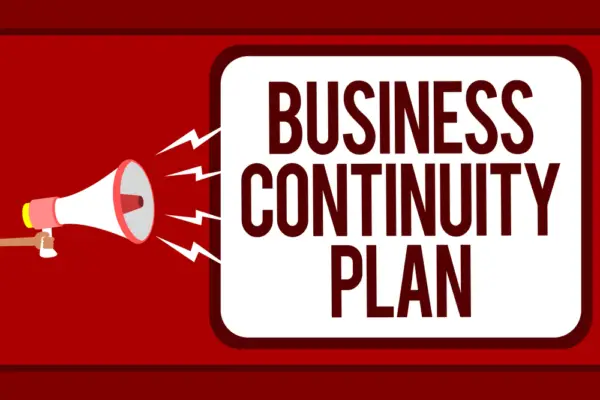When creating an IT business continuity plan, get the basics right so your IT systems are robust. Understand business continuity, identify critical functions, and map IT assets and risk.
Develop recovery objectives like RTO and RPO to guide your plan. Overcome the challenges by implementing and maintaining the plan.

Dive into best practices and regulatory compliance to strengthen your IT further. Follow these steps, and you’ll be safe.
Summary
- Identify IT functions and weaknesses.
- Develop IT-specific recovery plans.
- Test and refine IT continuity processes regularly.
- IT regulatory compliance.
- Hybrid cloud for IT resilience.
What is Business Continuity
Understanding Business Continuity is key to your organisation’s IT systems being robust. It means having strategies in place to keep your critical business functions running during disruptions and downtime.
It means doing a business impact analysis to identify key systems, setting recovery point objectives and business continuity strategies.
In the event of IT disruption due to natural disasters or other risks, having a disaster recovery plan in place means a quicker recovery.
Key people are key to this, so risk management is crucial. By prioritizing business continuity you can strengthen your organization and reduce the impact on your business.
Benefits of Business Continuity Planning
By having a business continuity plan, your organization can gain significant benefits in terms of operational resilience and cost savings, especially in reducing the impact of disasters on your IT systems.
Business continuity planning helps in crisis recovery, risk management and downtime prevention so your technology systems keep running even in major disasters.
It’s different from disaster recovery, which focuses on reactive measures to contain the spread of disruptions and downtime.
By having a solid BCP in place, you can reduce the financial loss of system outages and ensure your business is stable and secure in the face of unexpected events.
Business continuity planning is a strategic investment to protect your organization’s IT infrastructure and overall business.
Business Impact Analysis
When you do a Business Impact Analysis (BIA) you’ll be identifying critical functions evolving risks and threats to your organization.
By looking at your organization’s processes and mission-critical activities, you can see how IT disruption impacts your business.
This will help you prioritize disaster recovery plans and strategies and allocate resources to be resilient when things get tough.
Critical Functions and Threats
A Business Impact Analysis means identifying critical business functions and threats to ensure IT systems are resilient during disruptions. Through the BIA the impact of business function disruptions is assessed so you can make decisions on recovery priorities and strategies.
Use FEMA’s operational impact worksheet to simplify this process in your business continuity plan. By identifying critical functions that can be disrupted you can prioritise resources and effort.
Knowing the threats means you can take proactive measures to mitigate risk and strengthen your IT systems.
This is the basis for recovery strategies and to ensure critical operations can resume quickly after an incident and keep IT services running.
Organisation Processes and Mission Critical Processes
Start by looking at the organization’s processes and mission-critical functions to identify areas that impact IT continuity.
Look at the business processes, IT assets, departmental structures, applications, data, and systems that are critical to daily operations.
Look at how the workforce structure aligns with mission-critical processes to keep running smoothly during disruptions. Take a holistic view of the organization’s processes to understand the interdependencies between components.
IT Asset Mapping and Risk Assessment
When doing IT asset mapping for your business continuity plan you need to categorise assets by their impact.
Risk assessments across different areas will help you identify vulnerabilities and threats to your IT infrastructure.
IT Asset Mapping for Business Continuity
To have an effective business continuity plan for IT start by mapping your IT assets and do a detailed risk assessment.
Start by categorizing your assets by their business criticality. This is key to DR planning as it will determine the resources needed to keep continuity when things go down.
By mapping your IT assets and understanding their impact on your business, you can prioritize your effort and resources.
Identifying critical assets will guide you in developing strategies to mitigate risk and ensure your business can recover quickly from IT incidents.
Take the time to assess and categorize your assets accurately to strengthen your overall business continuity preparedness.
Risk Assessments Across Different Areas
Do a thorough risk assessment by looking at the likelihood and impact of threats to critical functions across different areas during the IT asset mapping and risk assessment process.
By doing assessments, you can rank risks by impact and likelihood. This includes looking at how each threat affects IT functions and doing an impact assessment to understand the outcome.
By doing a likelihood assessment, you can measure the probability of these risks happening.

Business Continuity Plan
When building a Business Continuity Plan for IT you need a dedicated team, organization and governance structure to manage the plan development and execution.
Set clear objectives and scope so the plan covers critical IT operations and recovery strategies.
These first steps will set the foundation for a solid Business Continuity Plan to protect your organisation’s IT infrastructure during disruptions.
Business Continuity Team and Governance
As you start building your Business Continuity Plan the first step is to establish a dedicated team with members from different departments to manage the plan development and implementation.
This business continuity team should have knowledge of business operations, governance, crisis management and regulatory compliance. By having members from different areas of expertise you will have a thorough approach to building a full business continuity plan BCP+.
This team will develop policies, standards, and procedures that align with the organization’s objectives. Communication and collaboration within the team are key to getting through the development and implementation phases.
Objectives and Scope
To progress with building a Business Continuity Plan focus on defining the objectives and scope to align with organizational goals and priorities.
The plan will achieve several objectives, including minimizing financial loss, keeping employees safe, maintaining business-critical operations, and protecting the company’s reputation.
By doing this you will ensure the Business Continuity Plan for IT covers the key areas for the organization to be resilient to disruptions.
Define the scope to outline the boundaries and focus of the plan clearly so it covers all the IT aspects and aligns with the overall organizational goals. This will guide the development of strategies to mitigate financial loss and protect critical operations.
Recovery Time Objectives (RTO) and Recovery Point Objectives (RPO)
When developing Recovery Time Objectives (RTO) and Recovery Point Objectives (RPO) for your business continuity plan you need to consider potential income and productivity loss scenarios.
Understanding the impact of downtime and data loss on your operations is key to setting realistic RTOs and RPOs that align to your business needs.
RTO/RPO for Income/Productivity Loss Analysis
During the development phase of the business continuity plan for IT, the RTO and RPO are set to analyze potential income and productivity loss.
By setting Recovery Time Objectives (RTOs) and Recovery Point Objectives (RPOs) the BCDR team can assess the impact of disruptions to mission-critical systems and processes and projected loss.
RTO/RPO in Business Continuity Planning
Setting Recovery Time Objectives (RTO) and Recovery Point Objectives (RPO) is key in business continuity planning for IT to get back up and running quickly and with minimal data loss during disruptions.
The Recovery Time Objective (RTO) is the maximum acceptable downtime for IT services after an incident, usually in hours, whilst the Recovery Point Objective (RPO) is the maximum data loss by specifying the time gap between the last backup and the incident.
Understanding your business, critical processes, and data dependencies is key to setting these values. Aligning RTO and RPO to your business priorities will help minimize operational disruption and data loss during IT incidents.
These values are crucial in developing IT recovery strategies and selecting the right backup and recovery solutions.
Full Plan
When developing a full business continuity plan for IT you need to detail all plan components and procedures.
This includes different business continuity methods and regular testing exercises to validate the plan.
Plan Components and Procedures
To develop a full business continuity disaster recovery plan for IT, you need to detail the components and procedures that include emergency contact information, recovery strategies, and specific actions for different scenarios.
In the plan emergency contact information should be available to all key stakeholders and personnel so communication can happen quickly during an incident.
Recovery strategies must be well-defined to address different natural disaster scenarios. Detailed actions must be outlined so the team knows what to do during and after an incident.
Frequently Asked Questions
What Is Business Continuity in an IT Context?
In an IT context, business continuity guarantees uninterrupted services during disruptions. Develop business continuity strategies to maintain critical IT functions and data, aiming to minimize downtime and data loss. Essential for mitigating risks and operational resilience.
What Are the 5 Components of a Business Continuity Plan?
You need to know the five components of a business continuity plan: risk assessment, business impact analysis (BIA), recovery strategies, plan development, and testing and maintenance.
These elements are essential for ensuring operational resilience.
What Is the Continuity Strategy of IT Service?
In the continuity strategy of IT service, focus on proactive measures to minimize outages, improve resilience, meet recovery objectives, and enhance service delivery.
Emphasize reducing downtime, adhering to SLAs, and evaluating impacts of new technologies.
What Is Continuity of Operations Plan Information Technology?
To guarantee IT functions continue during and after emergencies, a Continuity of Operations Plan (COOP) for Information Technology outlines established procedures for IT recovery, resumption of critical functions, and continuity of services.

Conclusion
A well-crafted business continuity plan for information technology is essential in ensuring the resilience and efficiency of your organization’s IT systems during disruptive incidents.
By conducting a thorough Business Impact Analysis, mapping out IT assets, and establishing clear Recovery Time Objectives and Recovery Point Objectives, you can proactively prepare for and navigate unforeseen challenges with resilience and effectiveness.
Implementing and regularly maintaining this plan will safeguard your technological infrastructure and maintain business continuity in the face of adversity.

Chris Ekai is a Risk Management expert with over 10 years of experience in the field. He has a Master’s(MSc) degree in Risk Management from University of Portsmouth and is a CPA and Finance professional. He currently works as a Content Manager at Risk Publishing, writing about Enterprise Risk Management, Business Continuity Management and Project Management.

